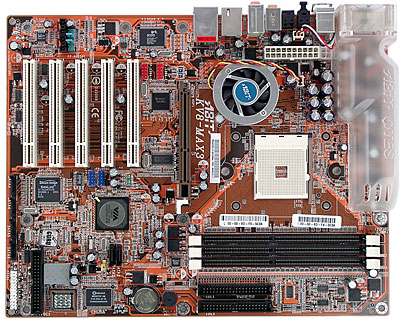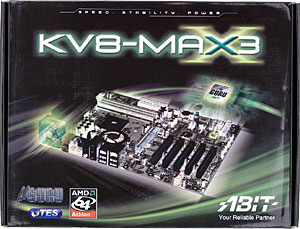ABIT KV8-MAX3 motherboard on VIA K8T800
|
Another high-end from ABIT meets the requirements, but it wasn't that good from the very beginning as the first boards refused to work in our lab, so the working revisions are 1.2 and newer (the problem is solved by unsoldering the PC Buzzer). We must state the not very comfortable location of OTES cooling system that sets against its own cover. Besides, cover screws are located just against board's mount holes, so a user might have to unscrew the cover and ream the holes for thicker screws that provide more reliable mount.

The circuitry is not very comfortable due to lots of controllers and sockets, in particular, the sockets located along the left border, and audio connectors situated in front of PCI slots. The installed graphics card prevents comfortable access to memory modules, while the plastic cover over transistors and capacitors of CPU voltage regulator might cause problems with cooler installation. Jumper access might be hindered during motherboard installation. Jumpers are described onboard. +5V Standby is indicated by a red LED. Another LED and ABIT OTES cooling are lit at switch-on. The 4-channel switching CPU voltage regulator has 9 x 2200µf and 3 x 1200µf capacitors. Besides, the board features AGP (2 x 1000µf and some smaller) and memory (2 x 1000µf) voltage regulators.
The board has no unsoldered circuitry. The board is sized 305x245mm (full ATX, 10-screw mount, firm fixation). Winbond W83627HF-AW chip is used to monitor:
- CPU, memory, AGP, battery, +3.3V, +5V, +12V, +5V Standby voltage;
- Rpm of 2 fans;
- CPU and motherboard temperatures (using corresponding sensors).
Onboard ports, connectors and sockets
- CPU Socket 754;
- 3 x DDR SDRAM DIMM;
- 1 x AGP;
- 5 x PCI;
- Standard ATX power and 4-pin 12V;
- 1 x FDD;
- 2 x IDE (Parallel ATA) in the chipset;
- 6 x SATA (Serial ATA) - 2 in the chipset, 2 on the additional
controller;
- 2 x USB (2.0) headers;
- 2 x FireWire headers;
- 1 x CD/DVD Audio connector;
- 1 x AUX-IN;
- 1 x modem audio connector;
- A header for additional audio connectors and S/PDIF;
- 5 x cooler connectors (2 controlled (one used by ABIT OTES);
one uncontrolled is used by the Northbridge fan).
Backpanel (left to right blockwise)

- ABIT OTES fan;
- PS/2 mouse and keyboard;
- 2 x SPDIF-In/Out (TosLink);
- Audio Rear, Center/Sub;
- Mic-In, Line-In, Front;
- 2 x USB and 1 x FireWire;
- 2 x USB and 1 x RJ-45 (Gigabit Ethernet).
Bundle

- A newly designed box;
- Manual: userís guide in 6 languages, quick start in 9 languages;
- 1 x ATA66/100/133, 1 x FDD (both encased into black cambric)
and 4 x SerialATA (with 1 power adapter splitter);
- Backpanel strap for 2 x USB and 1 x FireWire;
- ABIT Secure IDE;
- Backpanel stub;
- Software CD:
- drivers;
- Winbond Hardware Doctor monitoring utility;
- User's guide in Adobe Acrobat;
- Adobe Acrobat Reader;
- ABIT FlashMenu;
- DirectX 9.0.
Integrated controllers
- Avance Logic ALC658 AC'97 5.1 audio codec with front audio inputs/outputs
connector and S/PDIF;
- LAN on 3COM Marvell 940-MV00 supporting 10/100/1000Mbps with
Base-T (Gigabit Ethernet);
- SATA RAID on Silicon Image SiI3114CT176 supporting RAID 0, 1,
1+0, Spare;
- FireWire on Texas Instruments TSB43AB23 supporting 3 ports.
The integrated audio quality was tested in 16-bit, 44kHz mode using RightMark Audio Analyzer 5.1 and Terratec DMX 6fire:
| Frequency response
(from 40 Hz to 15 kHz), dB: |
+0.20, -0.14 |
Very good |
| Noise level,
dB (A): |
-87.7 |
Good |
| Dynamic range,
dB (A): |
87.1 |
Good |
| THD, %: |
0.0034 |
Very good |
| IMD, %: |
0.046 |
Good |
| Stereo crosstalk,
dB: |
-86.9 |
Excellent |
Summary: Very good (details).
Proprietary technologies
- ABIT OTES CPU voltage regulator cooling;
- ABIT Secure IDE HDD encryption;
- ABIT SoftMenu in-BIOS precise voltage and frequency adjustment.
Settings
| Jumpers and switches |
CMOS reset jumper |
|
| BIOS,
Phoenix 6.00PG |
Memory timings |
+ |
CAS Latency, Row
Cycle Time, Row Refresh Cycle Time, RAS to CAS Delay, RAS to
RAS Delay, Min. RAS Active Time, RAS Precharge Time, Write Recovery
Time, Write to Read Delay, Read to Write Delay |
| Memory frequency
selection |
+ |
DDR200, DDR266,
DDR333, DDR400 |
| AGP adjustment |
+ |
|
| PCI adjustment |
+ |
|
| AGP and PCI divider
adjustment |
- |
AGP(PCIx2) = Auto,
66-96 MHz |
| Manual IRQ settings |
+ |
|
| Manual FSB frequency |
+ |
200-300 MHz with
1MHz increments |
| CPU multiplier |
+ |
x4-x20 |
| CPU core voltage |
+ |
1.5-1.85V with 0.001V
(!!!) increments |
| Memory voltage |
+ |
2.5, 2.55, 2.6,
2.65, 2.7, 2.8, 2.9, 3.0, 3.1, 3.2 V |
| Chipset voltage |
+ |
1.2-1.4 V with 0.05V
increments |
| AGP voltage |
+ |
1.5, 1.55, 1.6,
1.65 V |
We used the BIOS 17 as the latest available at the moment of testing.
Test results:
Write a comment below. No registration needed!
|
|
 |
|
|
|



